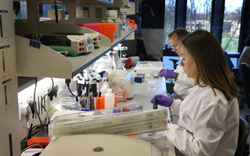A wide variety of breast cancer drugs are currently in use to treat the symptoms of the horrific disease. One specific drug, which has recently been noted for its potential in prolonging cancer remission, is Tamoxifen.
According to BreastCancer.org, it has been proven that the extended use of Tamoxifen can reduce the risk of breast cancer from coming back by 40 percent to 50 percent in postmenopausal women and by 30 percent to 50 percent in premenopausal women. Such results make a phenomenal difference because approximately 227,000 cases of breast cancer are diagnosed annually in the United States. Additionally, Tamoxifen has been proven to reduce the risk of a new cancer developing in the other breast by about 50 percent and has shown promising results in keeping cancer away from undiagnosed women who have family histories of breast cancer.
Typically, Tamoxifen is prescribed to breast cancer patients for approximately five years. However, in a new study called “Atlas,” Tamoxifen was assigned to one group of breast cancer patients for the average five years and to another group of patients for an extended 10 years. The results of this study showed that the group taking Tamoxifen for five years had a 25.1 percent recurrence rate of cancer while those who took the drug for 10 years had a 21.4 percent recurrence rate.
Such a difference is highly significant, especially when viewed through a personal and realistic lens. Freshman chemistry major Kristen Flynn comments that, “If it is scientifically proven that taking Tamoxifen reduces the chances of breast cancer from returning, then diagnosed patients should invest in the extra five years of treatment. Those five years can save them a lifetime. My cousin was diagnosed with breast cancer a year ago, Extended Use of Breast Cancer Drug Increases Remission so these advancements in medicine are the reasons why remission is possible.”
Breast cancer initially starts in the milk ducts of the breast, or in the lobes of the breast that produce milk. Further, breast cancer comes in two types. Invasive cancer spreads to other tissues besides the ducts and lobes, while noninvasive cancer remains in one type of tissue. The majority of breast cancers are susceptible to becoming tumors when in the presence of the hormone estrogen. These cancers are called estrogen-receptive positive cancers (ER-positive cancers) and Andrew Pollack of The New York Times reports that these cancers “account for about 65 percent of cases in premenopausal women.”
What makes Tamoxifen an optimal choice for treatment of estrogenreceptive positive cancers is that it blocks the effect of estrogen. This allows the drug to greatly reduce the chances of the breast cancer returning after surgery or remission. Tamoxifen also has the ability to shrink and treat ER- positive cancers prior to surgery, and, additionally, it can prevent the risk of cancer forming in undiagnosed women. Furthermore, this drug is easily distributed and taken orally as a pill.
The disadvantages of Tamoxifen are of course its side effects which possibly include hot flashes, mood swings, depression, weight gain, blood clots, and endometrial cancer.
Endometrial cancer forms in the uterus and is potentially very dangerous. However, this type of cancer is often diagnosed in its earliest stages, making it much easier to treat. Although the risk of developing endometrial cancer is 1.5 percent greater when taking Tamoxifen, Trevor J. Poweles of the Cancer Center London remarks that “overall, the benefits of extended Tamoxifen seemed to outweigh the risks substantially.”
Similarly, Dr. Dorothy Lobo, biology professor, said, “For some women with estrogen-receptor positive breast cancer, the use of tamoxifen has made a tremendous impact on their treatment and has extended lives. Though it is not without side effects (including strokes), so for each patient, the potential benefit versus the risks for using tamoxifen would need to be considered,” said Lobo.
She also said, “So much is now known about the molecular make-up of cancers that specific treatments are tailored to individuals – genetic testing of the tumors can help doctors identify which patients would benefit best from the variety of drugs such as tamoxifen or other targeted therapies, including monoclonal antibodies against other receptors that are known to be involved in cancer progression. Even though this trial indicates that extending the treatment with tamoxifen may only help a small subset of patients, for these patients, it would give them more time to be with their loved ones, which is priceless.”
Also, to counter the hot flashes and depression caused by Tamoxifen, patients can take antidepressants. The New York Times mentions one such patient who follows this procedure, a 39 year old single mother living in Texas named Emily Behrend. Behrend has completed her prescribed five years of taking Tamoxifen and is continuing her use of the drug. She says “If it can keep the cancer away, I’m all for it.”
Freshman biology major Priyal Patel agrees and said, “Although the side effects of Tamoxifen can be disastrous, the long term benefits- not getting breast cancer again- definitely outweigh the cons and treatment should continue for a long period of time. For those women that are hesitant to a prolonged treatment, we can only hope that the medical field finds a safer alternative in the near future.”
Overall, the use of Tamoxifen evidently has overruling benefits as opposed to harms. Therefore, the practice of extending the distribution of the drug will continue as of now.
Additional effects after 10 years of taking Tamoxifen remain yet to be seen. However, the current use of this drug is helping to save thousands of lives and we have increasing hope for more treatments and even potential cures.
IMAGE TAKEN from zimbio.com




